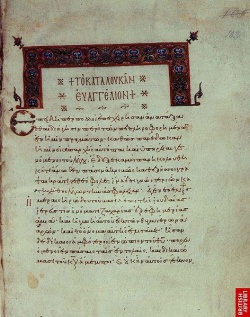Minuscule 481
From Textus Receptus
(→Description) |
|||
| Line 6: | Line 6: | ||
== Description == | == Description == | ||
| - | The codex contains the text of the [[Gospel]]s on 218 parchment leaves (size | + | The codex contains the text of the [[Gospel]]s on 218 parchment leaves (size 22.4 cm by 17.7 cm). Written in one column per page, 22 lines per page.<sup>[3]</sup> |
It is clean and elegant copy; before each Gospel is a picture of its writer, of no very high order of art, but curious enough.<sup>[4]</sup> | It is clean and elegant copy; before each Gospel is a picture of its writer, of no very high order of art, but curious enough.<sup>[4]</sup> | ||
The half page of writing erased at the end of the Gospel of John.<sup>[4]</sup> | The half page of writing erased at the end of the Gospel of John.<sup>[4]</sup> | ||
Revision as of 08:36, 5 December 2009
Minuscule 481 (in the Gregory-Aland numbering), ε 1017 (in the Soden numbering), is a Greek minuscule manuscript of the New Testament, on parchment. Paleographically it had been assigned to the 10th century.[1] Scrivener labeled it by number 569.[2]
Contents |
Description
The codex contains the text of the Gospels on 218 parchment leaves (size 22.4 cm by 17.7 cm). Written in one column per page, 22 lines per page.[3] It is clean and elegant copy; before each Gospel is a picture of its writer, of no very high order of art, but curious enough.[4] The half page of writing erased at the end of the Gospel of John.[4]
It is one of the very few manuscripts that are destitute of Liturgical apparatus. The style of the handwriting is unformed, the absence of all notes, κεφαλαια, etc. The only traces of which are red capitals in the marginal mark at John 13:31; the obelus at Luke 22:43.44.[4] Two inscriptions state that it belonged in 1809 to the Library of St. Laurence in the Escurial. The breathings and accents are complete and tolerably correct. There is no ι subscriptum but ι adscriptum in Mark 14:14; John 5:22 and in few other places. Itacisms are more frequent than in Codex 470. Erasures and corrections by a later hand exist, but are not very frequent. One of the most remarkable errors of scribe Scrivener noticed in Mark 2:12 and Mark 6:55 - κραβατγον (instead of κραβαττον).[4]
Text
The Greek text of the codex is a representative of the Byzantine text-type. Aland placed it in Category V.[5] Textually it is close to the codex 201.
History
The manuscript was held in Escorial, then it belonged to Charles Burney, as codices 480, 482, 484, 485, and ℓ 184.[3] It was purchased to the British Museum in 1818.[2]
The manuscript was examined and collated by Scrivener, who published its text in 1852.[3] The manuscript was added to the list of New Testament manuscripts by Scrivener.
It is currently housed at the British Library (Burney 19) in London.[1]
See also
References
- 1. Aland, K.; M. Welte, B. Köster, K. Junack (1994). Kurzgefasste Liste der griechischen Handschriften des Neues Testaments. Berlin, New York: Walter de Gruyter. p. 76. ISBN 3110119862.
- 2. Scrivener, Frederick Henry Ambrose; Edward Miller (1894). A Plain Introduction to the Criticism of the New Testament, vol. 1. London: George Bell & Sons. p. 257.
- 3. Gregory, Caspar René (1900). Textkritik des Neuen Testaments, Vol. 1. Leipzig. p. 194.
- 4. F. H. A. Scrivener, A Full and Exact Collation of About 20 Greek Manuscripts of the Holy Gospels (Cambridge and London, 1852), p. XLVIII.
- 5. Aland, Kurt; Barbara Aland; Erroll F. Rhodes (trans.) (1995). The Text of the New Testament: An Introduction to the Critical Editions and to the Theory and Practice of Modern Textual Criticism. Grand Rapids: William B. Eerdmans Publishing Company. p. 139. ISBN 978-0-8028-4098-1.
Further reading
- F. H. A. Scrivener, A Full and Exact Collation of About 20 Greek Manuscripts of the Holy Gospels (Cambridge and London, 1852), p. XLVIII. (as o)
- Frederic G. Kenyon, Facsimiles of Biblical Manuscripts in the British Museum (London, 1900), VI
External links
- Burney 19 at the British Library
- Wikipedia Article on Minuscule 481

